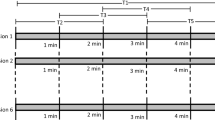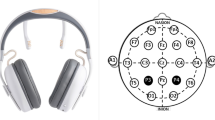Abstract
The possibility of voluntary training of the independent component of event-related potentials (ERPs) by the method of biological feedback (BFB) using a modified two-stimulus test of Go/NoGo paradigm was studied. Ten subjects had to increase the amplitude of the P3b component of ERPs induced by the Go stimulus during one training session. This component is generated in the parietal cortex and is associated with an operation of action engagement. The study consisted of three sessions that included determination of the average amplitude, training, and placebo. It was found that the amplitude of the P3b component did not significantly change during the training and placebo sessions as compared to the session of threshold measurement, whereas the amplitude of the SPD component, which was also observed in ERPs in response to the Go stimulus, significantly decreased in both sessions. According to the sLORETA data, the source of the SPD component is located in the parahippocampal area. The results obtained help to determine further pathways to study the possibility of the use of BFB for correction of components of cognitive evoked potentials.
Similar content being viewed by others
References
Lubar, J.F., Neocortical Dynamics: Implications for Understanding the Role of Neurofeedback and Related Techniques for the Enhancement of Attention, Appl. Psychophysiol. Biofeedback, 1997, vol. 22, no. 2, p. 111.
Kropotov, J.D., Quantitative EEG, Event-Related Potentials and Neurotherapy, New York: Academic Press, 2008.
Kropotov, Yu.D., Sovremennaya diagnostika i korrektsiya sindroma narusheniya vnimaniya (Modern Diagnostics and Correction of Attention Deficit Disorder), St. Petersburg: Elbi-Spb, 2005.
Snyder, E. and Hillyard, S.A., Long-Latency Evoked Potentials to Irrelevant, Deviant Stimuli, Behav. Biol., 1976, vol. 16, no. 3, p. 319.
Polich, J., Updating P300: An Integrative Theory of P3a and P3b, Clin. Neurophysiol., 2007, vol. 118, no. 10, p. 2128.
Bell, A.J. and Sejnowski, T.J., An Information-Maximization Approach to Blind Separation and Blind Deconvolution, Neural Comput., 1995, vol. 7, p. 1129.
Hyvärinen, A. and Oja, E., Independent Component Analysis: Algorithms and Applications, Neur. Networks, 2000, vol. 13, nos. 4–5, p. 411.
Hyvärinen, A., Survey on Independent Component Analysis, Neur. Comput. Surveys, 1999, no. 2, p. 94.
Jung, T.-P., Makeig, S., McKeown, M.J., et al., Imaging Brain Dynamics Using Independent Component Analysis, Proc. IEEE, 2001, vol. 89, no. 7, p. 1107.
Jasper, H.H., The Ten-Twenty Electrode System of the International Federation, Electroencephalogr. Clin. Neurophysiol., 1958, vol. 10, p. 371.
Author information
Authors and Affiliations
Additional information
Original Russian Text © M.V. Pronina, Yu.D. Kropotov, P.V. Murashov, 2011, published in Fiziologiya Cheloveka, 2011, Vol. 37, No. 3, pp. 13–18.
Rights and permissions
About this article
Cite this article
Pronina, M.V., Kropotov, Y.D. & Murashov, P.V. The possibility of using biofeedback for training the amplitude of independent components of event-related potentials. Hum Physiol 37, 278–282 (2011). https://doi.org/10.1134/S0362119711030133
Received:
Published:
Issue Date:
DOI: https://doi.org/10.1134/S0362119711030133




